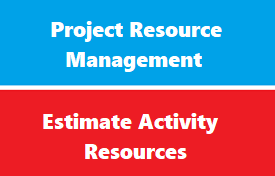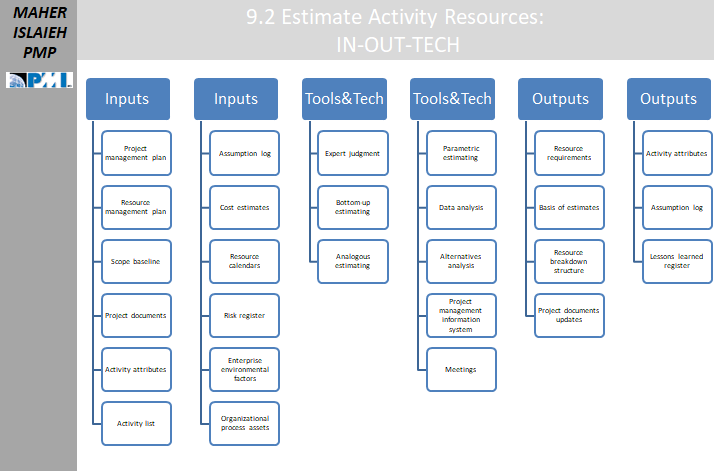introduction
Estimate activity resources process briefly helps to assign which resources in the project will do which project activities. Estimate activity resources process is the process of estimating the type and quantities of:
- Material,
- Human resources,
- Equipment,
- Supplies required to perform each activity.
estimate resources actions
Estimate resources Actions including but NOT limited to :
Review resource availability:
- Some of the needed project resources might not be present in your company. For instance, for a niche software development project requiring a specific set of skills, your company might not have any software developer meeting the requirements. In this case, alternatives such as outsourcing the required resource or hiring a new software developer must be planned.
Review WBS and activity list:
- Since activity resources will be estimated for the project activities, and these activities belong to the WBS and part of activity list, WBS and activity list must be reviewed during the Estimate Activity Resource Process. And necessary resource estimations will be done for each activity in the activity list respectively.
Identify potential available resources:
- If it is possible to allocate who will do a specific project activity, these must be identified.
Review historical info about reuse of resources:
- If there had been a similar project in the organization, that would be very useful for you to check what kind of resources have been used. Because, most probably, you will use similar resources in your project as well.
Review organizational policies on resource usage:
- There might be policies and guidelines on how to request a resource, how to assign a task, how to monitor etc. For instance, many corporate companies use PPM tool of HP. This tool helps to monitor project phases, assign activities to project team members and time reporting. These kinds of organizational policies on resource usage must be followed during the estimate activity resources process.
Expert judgment
- Based on the project activities, what kind of competence and experience must be looked in the project team member candidates can be obtained from subject matter experts. And the outputs of the experts will guide you on how to form project team respectively.
Analysis how to utilize resources:
- if you will need a graphic designer for your project and this team member will work only 2 days a week, it won’t be a good solution to dedicate this resource completely on the project. This can be outsourced to a vendor and required work might be acquired from them respectively. This will be less costly than hiring a new graphic designer or dedicating a resource 100% on the project.
Make or buy decisions are taken:
- Let’s assume that you need a crane for your construction project and you will need this only for 2 months and this is not a tool that your company uses in other projects. If the cost of the crane is $500,000 and rental cost of the crane for 2 months is $100,000, it will be a good decision to rent the crane. These kinds of make or buy decisions are taken during estimate activity resources process.
Break down the activity
- Although WBS is created and activity list is composed, some activities might be still large enough to estimate. In this case, a further breakdown of an activity can be done during the Estimate Activity Resources process.
Quantify resource requirements
- If you are managing a software project, you know that you will need analysts, software architects, software engineers, testers etc. But do you know how many from each of these roles you will need? Estimate activity resources process will help to quantify resource requirements by activity.
Create a hierarchical structure of resources:
- Actually, this is Resource Breakdown Structure and abbreviated as RBS. For instance, if you have 4 software engineers in the software project and 3 of them are reporting to one lead software engineer, this must be highlighted during.
Develop a plan of resources will be used:
- As we expressed already, roles you need in the project team, their hierarchy, skills, and competence must be highlighted.
Update project documents:
- As in many other processes, activities done in the estimate activity resources process require an update of project documents as well.
Inputs -Techniques - Outputs
Inputs
- Project management plan
- Resource management plan
- Scope baseline
- Project documents
- Activity attributes
- Activity list
- Assumption log
- Cost estimates
- Resource calendars
- Risk register
- Enterprise environmental factors
- Organizational process assets
Tools & Tech
- Expert judgment
- Bottom-up estimating
- Analogous estimating
- Parametric estimating
- Data analysis
- Alternatives analysis
- Project management information system
- Meetings
Outputs
- Resource requirements
- Basis of estimates
- Resource breakdown structure
- Project documents updates
- Activity attributes
- Assumption log
- Lessons learned register
Estimate Activity Resources: Inputs
Estimate Activity Resources Inputs include the following :
Project Management Plan
The components of the project management plan that are inputs to this process are:
- Resource management plan–output of process 9.1 Plan Resource Management. The plan will include methods for identifying and quantifying team and physical resources needed on the project.
- Scope baseline–identifies the project and product scope need to meet the project objectives. The purpose of this process is to estimate the resources needed to complete the scope of the project.
Project Documents
These are listed alphabetically in the PMBOK® Guide, but I am grouping them based on the knowledge area they were created in.
Integration management
- Assumption log–this may contain assumptions relating to resources, such as the availability and productivity level of the resources.
Schedule management
- Activity attributes–this will be where the estimates will go for the resources required for each activity on the activity list.
- Activity list–this identifies the activities that will need resources.
Cost management
- Cost estimates–these may affect the selection of resources depending on the cost of resources with various skill levels.
Resource management
- Identifies the organization’s schedule so that the availability of specific resources can be identified.
Risk management
- Risk register–this may contain risks relating to resource selection and availability.
Enterprise Environmental Factors
- Resource location, availability
- Published estimating data regarding resources, marketplace conditions
- Organizational culture
Organizational Process Assets
- Policies and procedures regarding team resources
- Policies and procedures regarding physical resources
- Historical information regarding the types of resources used for similar work on previous, similar projects.
Estimate Activity Resources Techniques
Estimate Activity Resources Techniques include :
Expert Judgment
- Expertise should be sought during this process by those who have specialized knowledge in estimating team and physical resources, or who have done such estimation for similar, previous projects.
Bottom-Up Estimating
- This estimation technique is bottom-up because it consists of estimation of the resources required for each activity and then aggregating all of these estimates into the level of work packages, control accounts, and then summary project levels.
Analogous Estimating
- This estimation technique using information regarding resources from a previous similar project.
- It is useful as a preliminary estimation when you have only completed the top few levels of the WBS, because you need to have a complete WBS in order to do the more accurate, but time-consuming Bottom-Up Estimating technique
Parametric Estimating
- This technique also uses information regarding resources from a previous similar project.
- The difference is that there is a statistical relationships between historical data and other variables which can be used to apply to the estimation of resources in the current project.
Data Analysis
- The main data analysis technique used in this process is alternatives analysis. There may be different options to accomplish a certain activity.
- These options may include various levels of resource capability or skills, for example.
- Alternatives analysis provides the best solution to perform the project activities within the defined constraints.
Project Management Information System (PMIS)
- This is the software tool (like Microsoft Project) used to help manage the resources on a project.
Meetings
- Planning meetings may be held with functional managers to help estimate the resources needed for each activity.
- Others at the meeting may include project team members who are responsible for estimation, experts who have knowledge regarding estimation techniques or who have worked on similar projects, and the project sponsor.
process Estimate Activity Resources : outputs
The outputs of the process Estimate Activity Resources include the following :
Resource Requirements
This document identifies the types and quantities of resource required for each work package or activity.
It is distinguished from these two other documents that have the word “resource:
- Resource breakdown structure –this is a preliminary document that is an output of Plan Resource Management which just lists the types of resources required for work on the project in general.
- The process Estimate Activity Resources takes this further in two ways: it lists not only the types of resources, but also the quantity needed.
- Resource calendar–This is a calendar that identifies the working days when each specific resource is available. This can be done at the level of the project in general, or it can be updated as a result of the process Estimate Activity Resources to the level of the work package or activity.
- So the resource breakdown structure answers the question of “what” when it comes to resources required for the project, the resource requirements adds the answer to the question “how much”, and the resource calendar adds the answer to the question “when”.
Basis of Estimates
Just like for the other two estimating processes, Estimate Activity Durations and Estimate Costs, it is important to keep track of how the estimation came about so that it is clear how the resource estimate was derived. That can include items like:
Methods used to develop the estimate (bottom-up estimating, analogous estimating, parametric estimating, etc.)
- Resources used to develop the estimate, particularly information from previous similar projects
- Assumptions associated with the estimate
- Known constraints (from other knowledge areas, such as schedule, budget, scope, risk, etc.)
- Range of estimates (usually expressed in terms of a plus or minus percentage)
- Confidence level of estimates (for example, a 90% probability of being able to obtain the resources within a given cost estimate)
- Documentation of identified risks influencing the estimate (these will go in the risk register)
Resource Breakdown Structure
- This is a preliminary document that is an output of Plan Resource Management which just lists the types of resources required for work on the project in general. The process Estimate Activity Resources takes this further in two ways: it lists not only the types of resources, but also the quantity needed. These two documents will be used to acquire and monitor resources in the upcoming processes, starting with Acquire Resources.
Project Documents Updates
- Activity attributes–the activity attributes, a description that gives information about each activity, are updated with the resource requirements.
- Assumption log–updated with assumptions regarding the types and quantities of resources required
- Lessons learned register–as with a lot of planning processes, the lessons learned register is updated with techniques that were found to be efficient and effective in developing resource estimates


